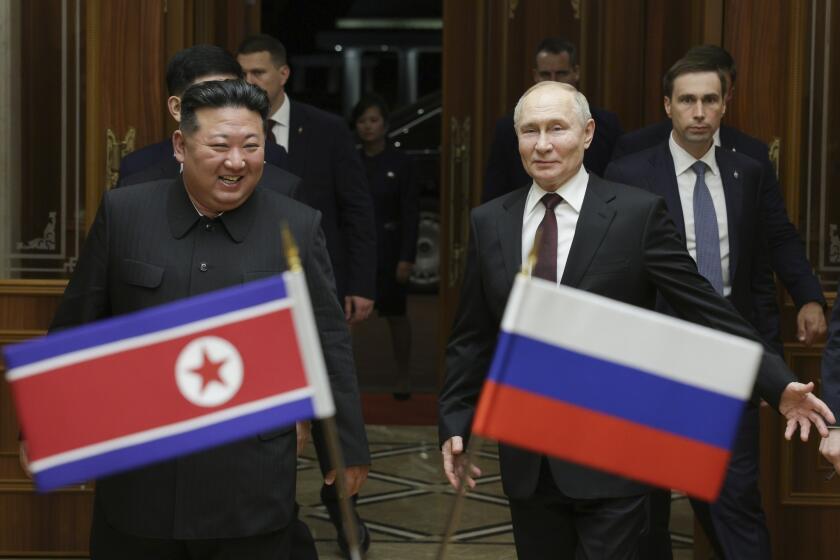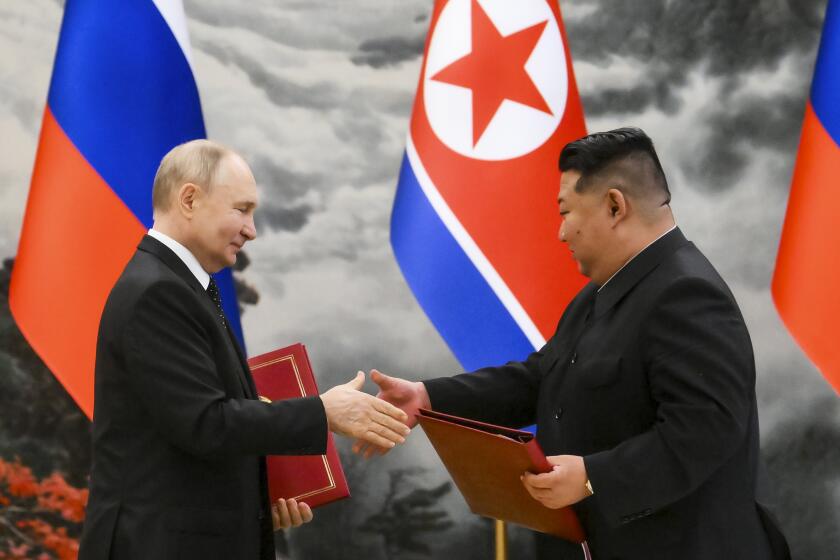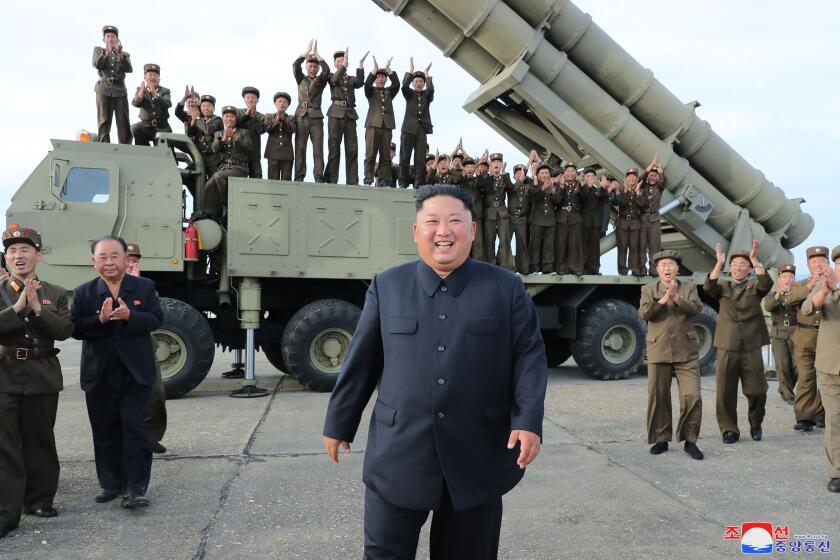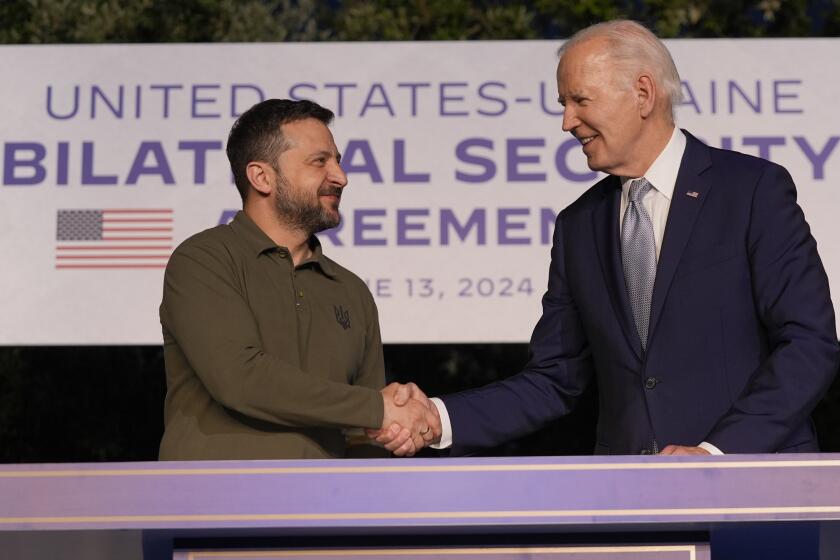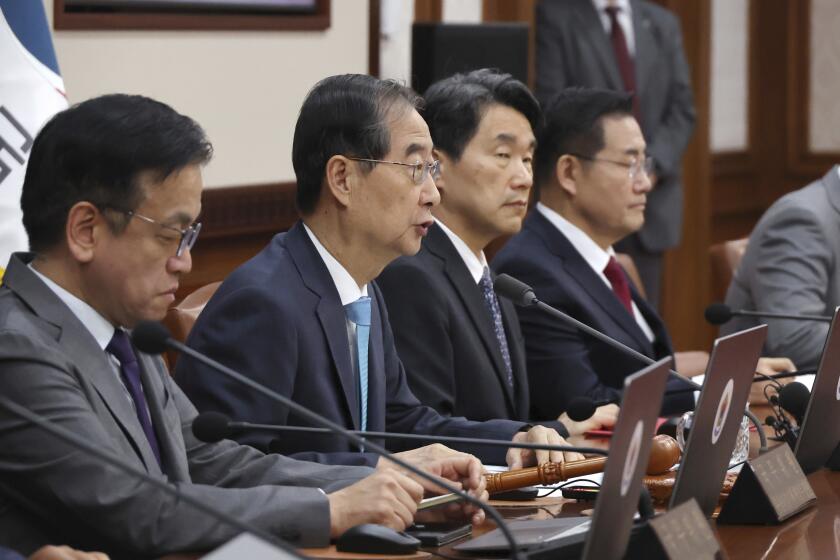What’s known, and not known, about the partnership agreement signed by Russia and North Korea
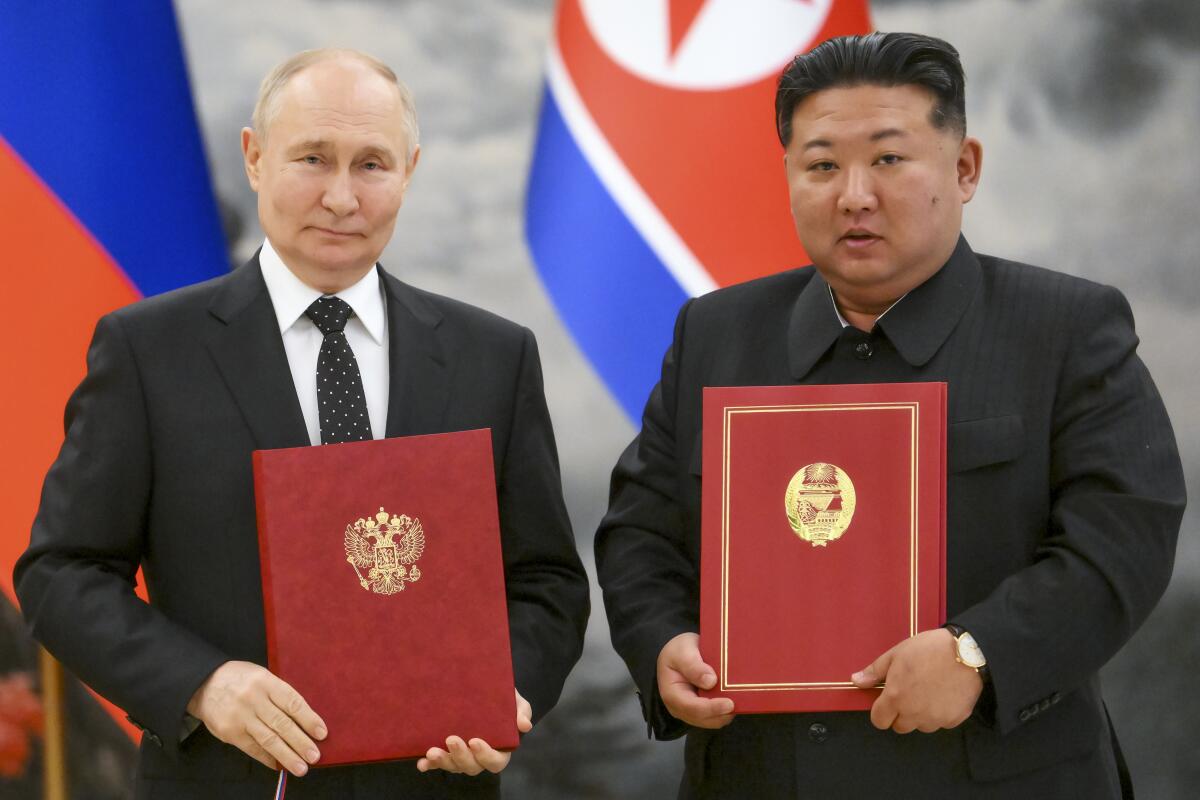
- Share via
SEOUL, South Korea — Both Russian President Vladimir Putin and North Korean leader Kim Jong Un say a new strategic partnership is a breakthrough, but what it means for their relationship is still uncertain.
The pact requires both countries to use all available means to provide immediate military assistance in the event of war, according to North Korean state media. While the agreement, inked Wednesday at a summit in Pyongyang, could represent the countries’ strongest deal signed after the Cold War, there are differing opinions on how strong the security commitment is.
Kim claimed that the deal elevated bilateral relations to the level of an alliance, while Putin was more understated and did not call it an alliance.
North Korean state media released the text of the agreement, which also includes broader cooperation in military, foreign policy and trade. Russia has not published its version of the text.
Putin, making his first trip to North Korea in 24 years, was met at Pyongyang’s airport by North Korean leader Kim Jong Un, according to news agencies.
Relations between sprawling Russia and small, isolated North Korea — both of them nuclear powers — have warmed significantly in recent years amid Russia’s growing acrimony with the West over the invasion of Ukraine and suppression of all domestic opposition.
One of the first knock-on effects of the agreement came Thursday, when South Korea’s government said it would reconsider its policy of limiting its support to Ukraine to nonlethal supplies. South Korea, a growing arms exporter, has provided humanitarian aid to Ukraine, but it has not directly provided weapons.
Here’s a look at what is known about the new partnership — and what is still unclear.
What did Russia and North Korea promise?
Most of the debate over the partnership agreement revolves around the article that pledges mutual aid. According to North Korean state media, the section states that if one of the countries gets invaded and is pushed into a state of war, the other must deploy “all means at its disposal without delay” to provide “military and other assistance.”
The agreement, which includes a vow of mutual aid if either country faces ‘aggression,’ appears to be the strongest since the Cold War.
But it also says that such actions must be in accordance with the laws of both countries and Article 51 of the United Nations Charter, which recognizes a U.N. member state’s right to self-defense.
To some analysts, that sounds like a promise that either nation would intervene if the other comes under attack, renewing a pledge made under a 1961 treaty between North Korea and the Soviet Union. That deal was discarded after the collapse of the USSR, replaced in 2000 by one that offered weaker security assurances.
Cheong Seong Chang, an analyst at South Korea’s Sejong Institute, said the agreement echoes the language of the 1961 treaty, as well as provisions of the U.S.-South Korea mutual defense treaty about activating channels to coordinate if either of faces the threat of invasion.
“North Korea and Russia have completely restored their Cold War-era military alliance,” Cheong said.
North Korea’s nuclear threat has been kept largely on the back burner by President Biden’s administration, but pressure has been rising.
Other experts were more cautious, saying the section is carefully worded to avoid implying automatic interventions and strictly limits the circumstances in which either country would be obligated to step in. And the language of the agreement is much less important than what each nation is actually capable of and willing to do, Du Hyeogn Cha, an analyst at Seoul’s Asan Institute for Policy Studies, said.
While it’s rare for any defense treaty to spell out specifically that a country is required to automatically intervene to defend a partner under attack, the strength of the commitment can be signaled in other ways, such as how the U.S. stations thousands of troops in South Korea and closely coordinates with its ally over training and weapons systems, Cha said. But Russia, for instance, doesn’t have a troop presence in North Korea and the countries have no established track record in joint military activities and coordination, aside from the North’s alleged munitions transfers to Russia.
The fact that the article invokes the countries’ domestic laws and the U.N. Charter could reflect that Russia tried to limit its defense obligation to very narrow conditions: when it’s clear North Korea did not instigate the aggression, the attack on the North is legally recognized in Russia as war, and Russia’s defense of the North is justified by the U.N., Cha said.
Biden and Zelensky sign deal on G-7 sidelines. The U.S. and European countries agree to freeze Russia’s sanctioned Russian assets until it pays Ukraine war reparations.
“The agreement is a symbolic statement vowing the expansion of cooperation, but it leaves a lot of room for interpretation when we get into practice,” Cha said. “The biggest concern about the summit isn’t whether [Russia] committed to an automatic military intervention or not, but the possible expansion of North Korean weapons transfers to Russia and the transfers of Russian military technologies to the North.”
What kinds of military cooperation are possible?
Putin said he would not “exclude the development of military-technical cooperation with the Democratic People’s Republic of Korea in accordance with the document signed today.”
That statement in effect formalizes something Western countries claim is already happening.
The U.S. and other allies allege that Russia has received ballistic missiles and ammunition from North Korea as the Ukraine war depletes Moscow’s inventory, and that Russia has made technology transfers to Pyongyang that could enhance the threat posed by Kim’s nuclear weapons and missile program.
North Korean state media also said the agreement requires the countries to take steps to strengthen their joint defense capabilities, but didn’t specify what those steps would be, or whether they would include combined military training.
South Korea’s resumption of firing exercises or propaganda loudspeaker broadcasts will likely prompt North Korea to take similar or stronger steps.
The agreement also calls for the countries to actively cooperate in efforts to establish a “just and multipolar new world order,” the North’s Korean Central News Agency said, underscoring how the countries are aligning as they face separate, escalating confrontations with the United States and its allies.
“Russia and North Korea will likely hold the specifics of this cooperation close to their chests, but the agreement is a way of letting the world — and particularly the United States and its allies know — that they’ll be working together,” said Ankit Panda, a senior analyst at the Carnegie Endowment for International Peace.
What’s the economic aspect of the pact?
The partnership also calls for developing economic ties, an especially important issue for North Korea as it suffers under an array of international sanctions. North Korea needs food, industrial materials and other goods, and in turn can supply Russia’s war-depleted workforce with labor. Those workers could then convert wages in rubles to dollars or euros, potentially becoming a source of the hard currency North Korea desperately needs.
Such activities would violate U.N. sanctions. Hours before he arrived in North Korea, Putin had vowed in an op-ed that the countries would overcomes sanctions together. Russia is the subject of Western sanctions for its invasion of Ukraine.
Putin said the Russian-North Korean trade turnover has risen ninefold over the past year, but admitted that the amount itself remains “modest.”
Kim and Heintz write for the Associated Press. Heintz reported from Tallinn, Estonia.
More to Read
Sign up for Essential California
The most important California stories and recommendations in your inbox every morning.
You may occasionally receive promotional content from the Los Angeles Times.
